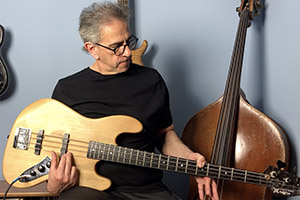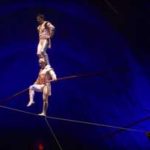Important things to think about when approaching your instrument
By Jon Liebman
Week of June 17, 2019
What a blast it was sitting down with Gerald Veasley at his annual Bass Boot Camp in Philly this year. We got to talking about so much stuff Gerald is into, like his current Nina Simone tribute project, the popular Unscripted Jazz Series, being president of the Jazz Philadelphia organization, bandleader duties, and lots more.
One thing that always comes up whenever I talk to Gerald is the eye-opening poem he wrote, at the suggestion of Joe Zawinul, about Thelonious Monk’s musical technique, citing how it had been labeled “incorrect” by at least one know-nothing musical purist.
Okay, so in analyzing Monk’s hand position, attack of the notes, articulation, etc., I suppose you can call it unorthodox. But does that make it wrong? Or bad? Think of all the other highly influential music icons throughout the generations who made their mark by playing “incorrectly.”
I remember watching a video of Louis Johnson demonstrating his slap bass technique and I noticed he had his left thumb curled over the top of the fingerboard in a way that some would consider downright criminal. Have you ever seen Quintin Berry play the bass? It looks like he’s holding the instrument upside down! Speaking of which, what kind of “incorrect” technique did Jimmy Haslip have to develop when he learned to play a righty bass upside down, like a lefty? And don’t get me started on Billy Sheehan.
Bass players aren’t the only nonconformist innovators. Anybody remember Jeff Healey’s laptop guitar technique? And I wonder what Dizzy Gillespie’s trumpet teacher would have said seeing those cheeks puff out in a way that’s just not “supposed” to be done.
The important thing is to do your job as a member of the band. In the online bass courses on this site, our lessons on basic technique are pretty traditional, for the most part, as that’s generally a good starting point. Once our members become proficient enough, and deserving of some poetic license, they may take their playing in an entirely different direction, maybe even an “incorrect” one.
As Gerald’s poem concludes, “I guess some folks say more in a few incorrect moments than most people say their whole ‘correct’ lives.” I won’t argue with that.
How about you? Do you have a thought on the importance (or lack thereof) of playing correctly? Leave a comment below. I’d love to know what you think.
In the meantime, you can check out my interview with Gerald here.
Learn Bass Online!






I can only think of one reason a technique might be “wrong”; if what you are doing interferes with your ability to build speed or do more advanced techniques. Example, trying to slap and your thumb is perpendicular to the strings.
I Believe if your using a technique thats a bit different for others, But makes you a better player That`s acceptable , But Using a off the wall technique just to look cool like hanging your bass somewhere around your knees ,Shows a certain lack of respect for your instrument. These type of technique`s in my opinion will hamper your ability to improve to your fullest potential, And could ruin your posture or even hurt your self long term.I truly believe Leo Fender got it correct when he designed the way the bass guitar would be played, Im a believer that its all been tried before, And what is standard procedure is what works the best, That is for most players. There are exceptions to every rule tho.
It’s wrong when you start to have medical issues, i.e., carpal tunnel syndrome. But playing “correctly” can definitely improve your playing skills, especially when it comes to reading on the job.
I was at first taken aback by the seemingly sewn-together fretting fingers of Danny “Mo” Morris. Is that technique correct? Over the past two months, I had the opportunity to enjoy two performances of Dywane (Mono Neon) Thomas. What informed him to play as he does would be a subject of an interesting interview with the soft-spoken virtuoso.
I guess technique can be considered a form of diversity. I feel there’s no correct way to approach playing an instrument, all of which have built-in compromises. It’s the musician’s task to adapt and find a technique that works with the instrument, accommodates their own physical limitations and musical skills, and to craft performances that ultimately please the ear.
As gear and music evolve, it seems only natural for technique to be malleable–something that develops and changes over time. There will always be the exceptional musician or luthier who will redefine the instrument or its role. Ultimately, the only thing that’s constant is change.